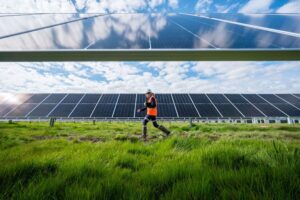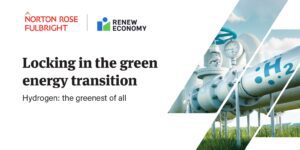August 16, 2023 marks the one year anniversary of the introduction of the landmark Inflation Reduction Act (IRA) in the US (aka the Green New Deal).
The Act is a cornerstone of the Biden administration’s program to reindustrialise the nation and secure cleantech supply chains against a backdrop of increasing geopolitical tensions, particularly with China, which dominates the global shift to clean energy.
The $US400 billion-plus IRA, the associated $US400 billion Loan Program Office, and the Infrastructure and Jobs Act – key planks of “Bidenomics” – are an unprecedented, open-ended stimulus into decarbonisation of the US economy.
These all-carrot, no-stick subsidy programs are turbocharging reindustrialisation and cleantech in the US – from battery manufacturing to solar and wind – boosting GDP and driving massive job creation.
The IRA is also of immense importance to the accelerating global investment and technology “race to the top”. The EU’s Net Zero Industry Act, India’s Production Linked Incentives, Japan’s GX Roadmap and Canada’s landmark clean energy tax credits are all direct responses to China’s dominance and the IRA.
In the domestic context, May saw a significant shift in geostrategic energy dynamics, with Prime Minister Albanese and President Biden agreeing on a Climate, Critical Minerals and Clean Energy Transformation Compact.
If approved by Congress, Australia will be deemed a domestic supplier under the IRA. This will make Australian companies and projects eligible to benefit from the ~US$800 billion of decarbonisation capital.
To take advantage of the opportunities afforded by its wealth of renewable energy, energy transition materials and critical minerals, Australia should seek to mobilise its own considerable domestic public and private capital to support national decarbonisation objectives.
Bold policy reform is a matter of urgency as global decarbonisation ramps up. We need an immediate, ambitious domestic response to our trade partners’ and competitors’ massive strategic national interest public subsidy programs.
We need it at a scale commensurate with that of Australia’s unique opportunity to leverage its world leading resources and renewable energy potential to position itself a zero-emissions trade an investment leader, and embody decarbonisation in our exports by powering value-adding with renewables.
Below, we review the Top 5 impacts of the IRA on its one year anniversary and outline the Top 5 steps Australia should take to secure our position in the new rapidly decarbonising world economy, with the immense benefits this entails for trade, investment, employment – and climate, as the climate crisis deepens.
Top 5 impacts of the IRA:
1. Boosting & greening the US economy
The IRA is driving an unexpected US economic surge, resulting in a sizable upward revision to US GDP forecasts on the back of a boom in large-scale infrastructure and domestic business investment rebound, led by manufacturing.
Bidenomics has crowded-in more than US$500 billion of new private sector investment in less than a year. The IRA has driven record new US jobs, while embedding fair labour standards in emerging clean industries. The program is a model of the impacts of large-scale strategic national interest cleantech policy and investment.
2. Creating a global race to the top
China is leading the race to dominate the zero emissions industries of the future, having moved strategically over the last decade to seize the employment, investment, market dominance, export and technology opportunities. But the US has moved decisively with the IRA’s ~US$800bn loan and subsidy programs to inject itself back into the race. This is belatedly mobilising global capital to cleantech at a scale the climate science demands.
3. Accelerating global energy transition
The world will see solar installs of 320-350GW in 2023, up 35-40% year on year (y-o-y), wind installs globally of 120GW, up 70% y-o-y, and EV sales of 14 million globally, up 30-35% y-o-y. Global integrated battery and solar manufacturing capacities are set to double over the 2 years to 2023, and then again in the following 2 years, with increasing geographic diversity.
We expect sustained ongoing solar and battery cost reductions over the rest of this decade. Deflationary renewables have won the cost argument, and this lead will accelerate. There is nothing slow or orderly now about this global energy transition – and the US IRA is both a response to and driver of this trend.
4. Elevating supply chain independence and security
Putin’s illegal war on Ukraine has made crystal clear the critical importance of supply chain security. The IRA is, in significant part, a US domestic response to securing independence and diversity of supply and decoupling from hyper-inflationary volatile fossil fuels.
This is now a security issue beyond the economics, as nations the world over enact comparable policy and public funding responses. China’s growing dominance of global supply chains gives rise to the need for ‘China +1’ thinking, undermining outdated WTO and globalisation concepts.
5. Turbocharging convergence of power, transport and industry decarbonisation
The technology convergence of these sectors is compounding the rate of change, driven by surging global battery capacities, and innovation and scaling up of renewables and manufacturing globally, including in the US, in competition to China’s lead.
The IRA, in directing unprecedented capital to a reindustrialisation of the US economy focussed around cleantech and energy transition, underpins and exemplifies this convergence.
Top 5 responses needed from Australia
1. Implement a priority national renewable energy & critical minerals superpower strategy
Professors Ross Garnaut and Alan Finkel have long argued Australia will be a new world economy superpower, leveraging our leading wind and solar resources, low population density, massive area, trusted global energy supply profile and strong capital markets, including for onshore value-adding of Australia’s abundant critical minerals and energy transition materials.
The time to act is now: Australia exported 50% of the world’s lithium in 2022, but did no on-shore value-adding. In 2023 we will see that change with renewables-powered lithium refining onshore, and we need to replicate this across all our metal and mineral exports.
2. Invest $100bn of strategic public capital
To seize the magnitude of its investment, employment and export opportunities, Australia needs another $100 billion of patient public capital and incentives – such as advanced manufacturing tax credits supporting domestic supply chains – to derisk the decarbonisation strategy and crowd-in $200-300bn of private capital.
This should include reforming the Future Fund to enable it to make long term national interest investments, updating YFYS benchmarks to mobilise our $3.5tn super capital pool into climate-aligned investments and establishing time-limited tax incentives and regulatory frameworks that make climate solutions and innovation accessible and bankable by retail and institutional investors (e.g. via verified Climate Bonds and infrastructure funds).
3. Roll out a national plan to electrify everything
The 2022/23 cost of living crisis stands in stark contrast to the $150bn gross profit made by mostly multinationals exporting Australia’s sovereign fossil fuel resources for their private, largely tax-free gains.
Fossil gas price hyperinflation domestically (outstripping export prices) has destroyed the industry’s social licence and accelerated initiatives such as Victoria’s Gas Substitution Roadmap, led by Energy Minister Lily D’Ambrosio. Underpinned by our world leading rooftop solar installs of over 20GW, the deflationary and decarbonisation merits of “electrifying everything”, long demonstrated by Saul Griffiths’ work, are now clear to all.
4. Price carbon emissions
The safeguard mechanism, in establishing a ratcheting-up price on carbon, is an important step to price-in this key externality, make polluters pay, and unlock capital into decarbonisation solutions. Federal Climate and Energy Minister Chris Bowen’s Australian carbon border adjustment mechanism (CBAM) proposal is a second step in building the policy framework to incentivise investment in zero emissions industries of the future, and is a necessary response to increasing activity globally on carbon tariffs by our trade partners and competitors.
5. Collaborate with world leaders in zero-emissions manufacturing
Australia needs to move at speed and scale to rebuild domestic manufacturing capacity, including via the $15bn National Reconstruction Fund chaired by Martijn Wilder – a key Federal initiative to drive the strategic move away from the dig-and-ship mentality of old and into the export of green iron, lithium hydroxide and cleantech supply chain.
A key here is collaboration on reindustrialisation with world leaders in zero-emissions technologies like LG and POSCO of Korea, Brookfield of Canada, CATL of China, Komatsu of Japan and Reliance of India, through arrangements such as bi/multilateral trade and investment agreements and partnerships.
The clock is ticking
With urgent action on targeted, ambitious policy incentives and strategic investment, Australia is positioned to emerge in the new world economy as a value-added critical minerals superpower, leveraging the global energy system decarbonisation trend that accelerated dramatically in 2022/23.
Our economic, trade, employment, and geostrategic opportunity to take a leadership role in the zero-emissions world is unprecedented.
By Tim Buckley, founder and director, Climate Energy Finance and Blair Palese, founder, Climate Capital Forum and philanthropy director, Ethinvest








